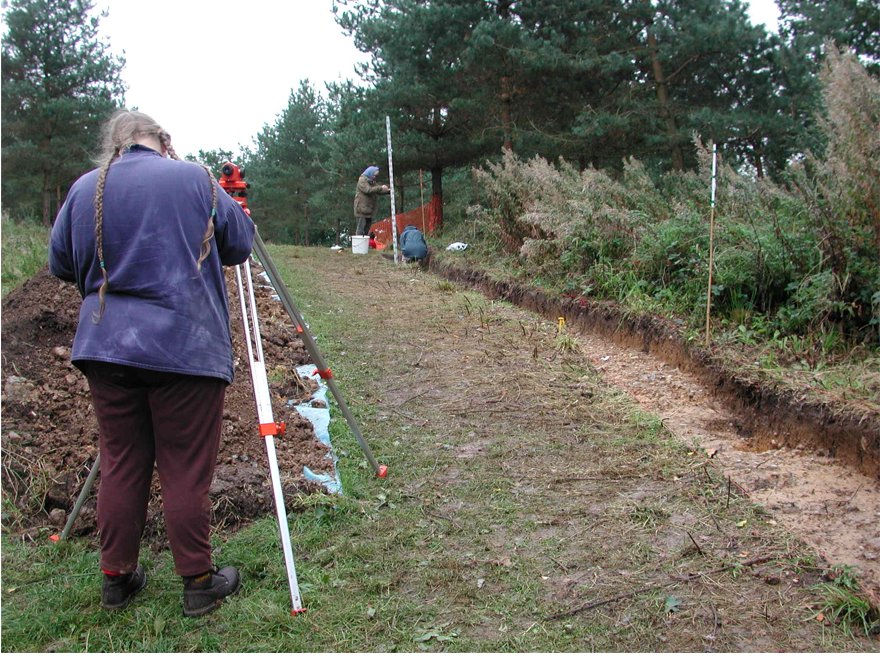A particularly enjoyable outcome of the Wessex Hillforts and Habitats Project ..was to complete a guide book which features each of the 12 hillforts of the project …plus the Cerne Giant.
Marie, our project manager made this happen,sourcing and co-ordinating all the text and images.
It is about to go online and to print.
There was some funding for reconstruction drawings.
Trying to imagine a place as it may have looked in the Iron Age is challenging but exciting ….the skills of a patient artist are essential
Who knows whether something looks right… using the available evidence….. until it is drawn.
Marie commissioned Julia Lillo to create two illustrations for the new guide book. One for Figsbury Ring and one for Park Hill Camp in Wiltshire. National Trust was also given permission to use Julia’s Badbury Rings drawing which had accompanied an article in Ancient History Magazine.

This reconstruction had used an air photograph taken over the east entrance of the hillfort.
Which was backed up by a LiDAR image of the earthworks.

I looked at the original drawing again..
We had carried out several excavations and geophysical surveys within the Badbury landscape. There were also many air photographs showing crop and soil marks of features below the ploughsoil.
So there was much we could show in the Iron Age view beyond the hillfort…It definitely needed some work.
I sketched out what I thought over the weekend and sent it to Julia.
She gave us a black and white line drawing and then there followed a conversation of sketches and alterations. Until the rough coloured image was created and eventually the final image.
Though it will be one image on a guide book page..Julia has shown a lot of detail that can be zoomed into.

Just beyond the west side of the hillfort is the site of the Iron Age temple site we excavated in 2000 with its enclosure around it. It has been imagined within an enclosure with totem poles with antlers on them.
The drawing shows the temple amongst the Bronze Age round barrows. Many are still large earthworks but other smaller barrows have been picked up using geophysical survey.
In the background are typical small ‘celtic’ fields of the Iron Age and a hut within an enclosure representing one of the many farmstead sites found in the Badbury landscape.
The drawing is crossed by trackways; some lying alongside the earthworks of later Bronze Age ‘ranch’ boundaries or ‘linears’ which divided up the landscape from about 1000 BC.
Inside the hillfort there are the sites of many round houses.. and as you walk round the hillfort, and get your eye in, their circular hollows can be seen terraced into the rounded dome of the hill top. Julia has shown walkways and palisades on the tops of the ramparts.
One Bronze Age barrow was included in the hillfort when the outer rampart was constructed. It is still a clear earthwork.

In 2004, when we excavated inside Badbury, we found grain and plant remains trampled into the floor of one of the round house hollows with pottery and oak charcoal dated to about 200 BC.
Julia has shown a busy hillfort settlement. The houses in small enclosures with outhouses, people and livestock.
A gateway leads to the ‘barbican’ enclosure. The middle rampart kinks out to create a space, perhaps a secure area for livestock.


Panning out, the drawing shows a circular area within the centre and highest point of the hillfort. Perhaps reserved for a special purpose. Sacred? or for a leader’s high status residence. There are traces of an early earthwork enclosure here though it has been disturbed by 18th and 19th century tree plantation banks.

Here is the whole drawing !
Around the hillfort, I suggested sheep and cattle pasture but on the better soils, towards the River Stour, there are small arable fields and farmsteads stretching into the distance.
The eastern Iron Age gateways through the three ramparts can be seen in the foreground.
The drawing is an interpretation to try to understand what life was like when Badbury was at its best, over 2000 years ago….. but new discoveries will provide fresh evidence which will enable us to draw a more accurate picture.
For example, the ramparts could be freshly made. They’d be bright white from the newly dug chalk bedrock hacked from the ditches.
